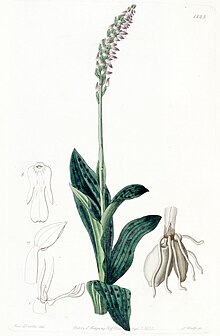Chaste orchids
| Chaste orchids | ||||||||||||
|---|---|---|---|---|---|---|---|---|---|---|---|---|

Keuschorchis ( Neotinea maculata ) |
||||||||||||
| Systematics | ||||||||||||
|
||||||||||||
| Scientific name | ||||||||||||
| Neotinea maculata | ||||||||||||
| ( Desf .) Stearn |
The Keuschorchis ( Neotinea maculata ), also known as the spotted woodroot , is a species of the genus Neotinea in the orchid family (Orchidaceae).
description
Vegetative characteristics
Neotinea maculata is a perennial herbaceous plant that reaches heights of 8 to 30 centimeters. Two round, undivided plant tubers are formed as persistence organs . The stem is slender, slightly curved back and forth.
From two to six leaves , two or three are arranged in a basal rosette and the others are arranged alternately on the stem. The leaf blade of the basal leaves is 3 to 12 centimeters long and 1 to 3 centimeters wide, oblong-ovate and spotted or unspotted. The stem leaves are smaller and sheath-shaped.
Generative characteristics
The terminal, racemose inflorescence is narrow-cylindrical with a length of 2 to 10 centimeters and densely covered with numerous flowers on all sides. The bracts are lanceolate, about two-thirds as long as the ovary and adjacent to it.
The relatively small, hermaphrodite flowers are zygomorphic and threefold. The bracts are whitish, greenish-white or pink in color. The bracts are helm-shaped, the sepals are pointed-lanceolate, the petals pointed-linear. The lip is 3 to 3.5 millimeters long and 2.5 to 3 millimeters wide and strongly divided into three parts. The split part of the middle lobe is wedge-shaped, often with two columns at the tip and curved downwards. The split pieces of the lateral lobes are linear and narrower than the middle lobes. The spur is conical, obtuse and slightly curved downwards.
The flowering period extends from March to May.
The number of chromosomes is 2n = 40.
ecology
Neotinea maculata is a tuber geophyte .
The massulae , which disintegrate spontaneously in the flower , fall onto the stigma and trigger autogamy .
Occurrence
The distribution area of Neotinea maculata extends from the Mediterranean area , from North Africa to northwestern Europe and Macaronesia . There are localities for the Canary Islands as well as Madeira , Algeria , Morocco , Tunisia , Libya , Israel and Palestine , Lebanon to Syria , Turkey , Greece , Cyprus , Crete and the islands of the eastern Aegean, the Balearic Islands , Corsica , Sardinia , Sicily , France , Italy , Portugal , Spain , Ireland , the United Kingdom and the former Yugoslavia . Neotinea maculata thrives in the laurel forest , the pine forests and the tree heather bushes of Madeira and the Canary Islands and in the Mediterranean area in partially shaded locations in pine trees , on walls exposed to the north, also in the phrygana and maquis . It grows at altitudes from 0 to 2000 meters.
Taxonomy
The first description was in 1799 under the name ( Basionym ) Satyrium maculatum by René Desfontaines in Fl. Atlant. 2, page 319. The new combination to Neotinea maculata (Desf.) Stearn was published in 1974 (publ. 1975) by William Thomas Stearn in Annales Musei Goulandris , 2, page 79. Other synonyms for Neotinea maculata (Desf.) Stearn are: Aceras densiflorum (bread.) Boiss. , Aceras intactum (Link) Rchb. f. , Aceras maculatum (Desf.) Gren. , Aceras secundiflorum (Bertol.) Lindl. , Coeloglossum densiflorum Hartm. ex will. & Lange , habenaria intacta (Link) Lindl. ex Benth. , Himantoglossum parviflorum Spreng. , Himantoglossum secundiflorum (Bertol.) Rchb. , Neotinea intacta (Link) Rchb. f. , Ophrys densiflora (bread.) Desf. , Ophrys secundiflora Steud. , Orchis atlantica Willd. , Orchis ecalcarata Costa & Vayr. , Orchis imbecilla Sol. ex Britten , Orchis intacta Link , Orchis sagittata Munby , Orchis secundiflora Bertol. , Peristylus atlanticus (Willd.) Lindl. , Peristylus densiflorus (bread.) Lindl. , Peristylus maculatus Lindl. ex Rchb. f. , Satyrium atlanticum (Willd.) Lindl. Bread , Satyrium densiflorum . , Satyrium parviflorum pers. , Tinea cylindrica Biv. , Tinea intacta (Link) Boiss. , Tinea maculata (Desf.) Vis. , Neotinea maculata var. Stricta Landwehr .
Individual evidence
- ↑ Peter Schönfelder , Ingrid Schönfelder: The new cosmos Mediterranean flora. Franckh-Kosmos-Verlag Stuttgart 2008, ISBN 978-3-440-10742-3 , p. 384.
- ↑ a b c d e Helmut Baumann , Siegfried Künkele , Richard Lorenz: Orchids of Europe with adjacent areas. Verlag Eugen Ulmer, Stuttgart, 2006, ISBN 978-3-8001-4162-3 , p. 127.
- ^ Neotinea maculata at Tropicos.org. Missouri Botanical Garden, St. Louis
- ↑ a b Rafaël Govaerts, 2003: World Checklist of Monocotyledons Database in ACCESS: 1-71827. The Board of Trustees of the Royal Botanic Gardens, Kew. Rafaël Govaerts (Ed.): Neotinea maculata. In: World Checklist of Selected Plant Families (WCSP) - The Board of Trustees of the Royal Botanic Gardens, Kew . Retrieved July 13, 2020.
- ^ Neotinea maculata at Tropicos.org. Missouri Botanical Garden, St. Louis, accessed July 13, 2020.
Web links
- Data sheet from Flora Italiana in Schede di botanica with distribution maps and photos.
- Data sheet at Flora-on with distribution in Portugal and photos.
further reading
- Karl J. Duffy, Giovanni Scopece, Salvatore Cozzolino, Michael F. Fay, Rhian J. Smith, Jane C. Stout: Ecology and genetic diversity of the dense-flowered orchid, Neotinea maculata, at the center and edge of its range. In: Annals of Botany , Volume 104, 2009, pp. 507-516. doi : 10.1093 / aob / mcn200 full text PDF.
- Peter Schönfelder, Ingrid Schönfelder: What is in bloom in the Mediterranean ?: With over 850 photos . Kosmos, 2014, ISBN 978-3-440-14512-8 ( limited preview in Google Book Search).

